The jaw strength of a wolf is impressive, especially when considering the animal’s need to catch and eat prey in the wild. Wolves are apex predators, and their jaws are adapted to hunt, tear, and chew through tough materials such as bone, muscle, and cartilage.
The bite force of a wolf is measured in pounds per square inch (PSI), which quantifies the pressure exerted by the teeth when biting. Research has shown that the bite force of a wolf can vary depending on the species and the individual, but the typical PSI of a wolf’s jaw is around 1,200 PSI.
How This Compares to Other Animals:
- Humans: A typical human bite force is around 160-200 PSI, much lower than that of a wolf.
- Domestic Dogs: While domestic dogs can have a strong bite, their PSI is typically lower than that of wolves, ranging from 320 to 450 PSI, depending on the breed.
- Other Predators:
- Lions: Lions can exert up to 650 PSI with their bite.
- Tigers: Tigers, larger and more powerful than lions, can exert 1,000 PSI.
- Crocodiles: A saltwater crocodile, one of the strongest animals, can exert a bite force of 3,700 PSI.
Why Is the Wolf’s Bite So Powerful?
The wolf’s jaw is designed to handle the physical demands of hunting and consuming meat, including tough and fibrous tissue and bones. Several factors contribute to the wolf’s powerful bite:
- Large Canines: Wolves have long, sharp canines for grabbing, holding, and tearing meat.
- Strong Jaw Muscles: Wolves have highly developed jaw muscles that allow them to generate significant pressure when biting.
- Efficient for Hunting: The high PSI is essential for breaking bones and consuming a variety of prey, from small animals to large ungulates (e.g., deer, elk).
A wolf’s jaw can exert around 1,200 PSI, allowing it to effectively hunt and process its prey in the wild. This bite force is much stronger than that of a human and is comparable to other large predators, enabling wolves to thrive as apex predators in their ecosystems.


